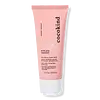What's inside
What's inside
 Key Ingredients
Key Ingredients

 Benefits
Benefits

 Concerns
Concerns

 Ingredients Side-by-side
Ingredients Side-by-side

Water
Skin ConditioningDisodium Cocoamphodiacetate
CleansingPropanediol
SolventAvena Sativa Kernel Oil
Skin ConditioningPolyglyceryl-4 Caprate
EmulsifyingPolyglyceryl-6 Caprylate
EmulsifyingGlycerin
HumectantXanthan Gum
EmulsifyingCitric Acid
BufferingGluconolactone
Skin ConditioningCarrageenan
Rosa Rubiginosa Seed Oil
EmollientSodium Benzoate
MaskingAnthemis Nobilis Flower Oil
MaskingRosa Damascena Flower Oil
MaskingCitronellol
PerfumingGeraniol
PerfumingWater, Disodium Cocoamphodiacetate, Propanediol, Avena Sativa Kernel Oil, Polyglyceryl-4 Caprate, Polyglyceryl-6 Caprylate, Glycerin, Xanthan Gum, Citric Acid, Gluconolactone, Carrageenan, Rosa Rubiginosa Seed Oil, Sodium Benzoate, Anthemis Nobilis Flower Oil, Rosa Damascena Flower Oil, Citronellol, Geraniol
Water
Skin ConditioningGlycerin
HumectantBetaine
HumectantMusa Sapientum Fruit Extract
Skin ConditioningSaccharomyces Ferment
Skin ConditioningCapryl/Capramidopropyl Betaine
CleansingArginine
MaskingXanthan Gum
EmulsifyingPolyglyceryl-6 Caprylate
EmulsifyingPolyglyceryl-4 Caprate
EmulsifyingPolyglyceryl-4 Cocoate
EmollientPolyglyceryl-6 Ricinoleate
EmulsifyingHibiscus Sabdariffa Flower Extract
Skin ConditioningIsoamyl Laurate
EmollientSodium Chloride
MaskingVitis Vinifera Fruit Extract
Skin ConditioningSodium Hyaluronate
HumectantLactic Acid
BufferingPhenylpropanol
MaskingCitric Acid
BufferingTartaric Acid
BufferingGluconic Acid
Water, Glycerin, Betaine, Musa Sapientum Fruit Extract, Saccharomyces Ferment, Capryl/Capramidopropyl Betaine, Arginine, Xanthan Gum, Polyglyceryl-6 Caprylate, Polyglyceryl-4 Caprate, Polyglyceryl-4 Cocoate, Polyglyceryl-6 Ricinoleate, Hibiscus Sabdariffa Flower Extract, Isoamyl Laurate, Sodium Chloride, Vitis Vinifera Fruit Extract, Sodium Hyaluronate, Lactic Acid, Phenylpropanol, Citric Acid, Tartaric Acid, Gluconic Acid
Ingredients Explained
These ingredients are found in both products.
Ingredients higher up in an ingredient list are typically present in a larger amount.
Citric Acid is an alpha hydroxy acid (AHA) naturally found in citrus fruits like oranges, lemons, and limes.
Like other AHAs, citric acid can exfoliate skin by breaking down the bonds that hold dead skin cells together. This helps reveal smoother and brighter skin underneath.
However, this exfoliating effect only happens at high concentrations (20%) which can be hard to find in cosmetic products.
Due to this, citric acid is usually included in small amounts as a pH adjuster. This helps keep products slightly more acidic and compatible with skin's natural pH.
In skincare formulas, citric acid can:
While it can provide some skin benefits, research shows lactic acid and glycolic acid are generally more effective and less irritating exfoliants.
Most citric acid used in skincare today is made by fermenting sugars (usually from molasses). This synthetic version is identical to the natural citrus form but easier to stabilize and use in formulations.
Read more about some other popular AHA's here:
Learn more about Citric AcidGlycerin is already naturally found in your skin. It helps moisturize and protect your skin.
A study from 2016 found glycerin to be more effective as a humectant than AHAs and hyaluronic acid.
As a humectant, it helps the skin stay hydrated by pulling moisture to your skin. The low molecular weight of glycerin allows it to pull moisture into the deeper layers of your skin.
Hydrated skin improves your skin barrier; Your skin barrier helps protect against irritants and bacteria.
Glycerin has also been found to have antimicrobial and antiviral properties. Due to these properties, glycerin is often used in wound and burn treatments.
In cosmetics, glycerin is usually derived from plants such as soybean or palm. However, it can also be sourced from animals, such as tallow or animal fat.
This ingredient is organic, colorless, odorless, and non-toxic.
Glycerin is the name for this ingredient in American English. British English uses Glycerol/Glycerine.
Learn more about GlycerinPolyglyceryl-4 Caprate comes from Capric Acid and Polyglycerin-4. It is an emulsifier.
Emulsifiers help stabilize a product. They do this by preventing ingredients from separating, such as oils and water which do not mix naturally.
Polyglyceryl-6 Caprylate comes from caprylic acid and Polyglycerin-6. It is an emulsifier, emollient, and cleansing agent.
Emulsifiers help stabilize a product. It does this by preventing certain ingredients from separating. Common ingredients include oils and water, which do not mix naturally. Emulsifiers have properties that help keep ingredients such as these together. There is emerging research that shows emulsifiers may also help in delivering ingredients into the skin.
As an emollient, polyglyceryl-6 caprylate helps soften skin.
Learn more about Polyglyceryl-6 CaprylateWater. It's the most common cosmetic ingredient of all. You'll usually see it at the top of ingredient lists, meaning that it makes up the largest part of the product.
So why is it so popular? Water most often acts as a solvent - this means that it helps dissolve other ingredients into the formulation.
You'll also recognize water as that liquid we all need to stay alive. If you see this, drink a glass of water. Stay hydrated!
Learn more about WaterXanthan gum is used as a stabilizer and thickener within cosmetic products. It helps give products a sticky, thick feeling - preventing them from being too runny.
On the technical side of things, xanthan gum is a polysaccharide - a combination consisting of multiple sugar molecules bonded together.
Xanthan gum is a pretty common and great ingredient. It is a natural, non-toxic, non-irritating ingredient that is also commonly used in food products.
Learn more about Xanthan Gum